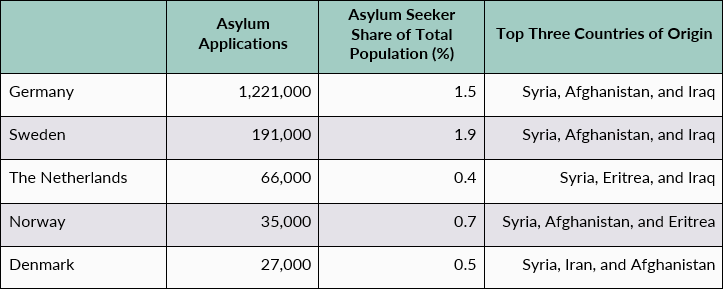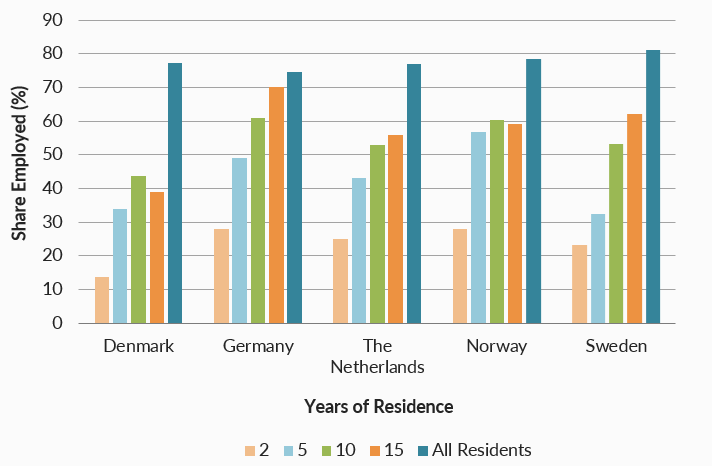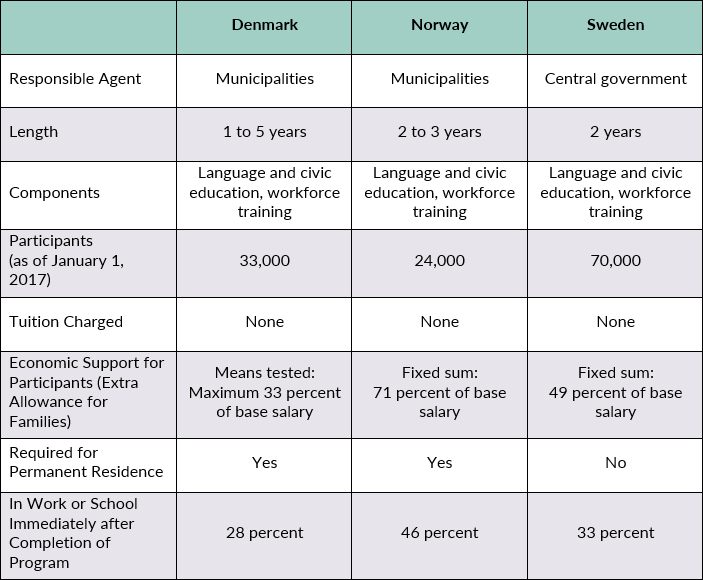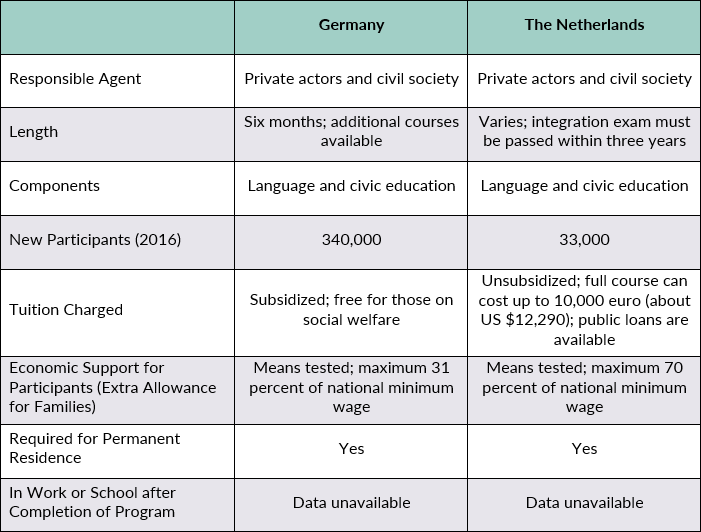You are here
Newcomers in the North: Labor Market Integration of Refugees in Northern Europe

Refugees attend a job training fair in Germany. (Photo: Handwerkskammer für München und Oberbayern)
In 2015 and 2016, nearly 2.7 million asylum seekers arrived in the European Union, comprising the largest mass movement in Europe since World War II. More than half chose to apply for asylum on the northernmost edge of the continent: Germany was the top destination country by far, but much-smaller Sweden received more asylum applications relative to its population. The Netherlands, Norway, and Denmark also saw significant numbers. Since then, these five countries—high-income states known for their generous welfare systems and hospitality toward protection seekers—have turned to the sizable task of integrating the new arrivals into the labor market.
Northern European countries are no strangers to immigration, having received more than 2 million asylum seekers between 2000 and 2014, in addition to significant numbers of intra-EU migrants. However, despite their relatively welcoming attitude, these countries are marked by high barriers to entry in the labor market for humanitarian arrivals, and many refugees who arrived in previous decades found it harder than anticipated to find work and a footing in society. In addition, humanitarian migrants in some countries have fared much better than elsewhere; for example, after ten years in the country, more than 60 percent of refugees in Germany were employed, compared to roughly 45 percent in Denmark.
In light of the major inflows of primarily Syrian, Afghan, and Iraqi asylum seekers in 2015 and 2016, governments are reconsidering their integration policies in an attempt to ease asylum seekers’ transition into the job market. This article compares labor market outcomes among earlier waves of successful asylum applicants (referred to here as refugees) and integration programs across five Northern European countries—Denmark, Germany, the Netherlands, Norway, and Sweden—and identifies key lessons governments can learn from the varied experiences refugees have in finding work. The findings are adapted from the author’s book, Inspiration for Integration, originally published in Swedish.
Table 1. Asylum Applications in Northern European Countries, 2015-16

Sources: Eurostat, “Asylum and First Time Asylum Applicants by Citizenship, Age and Sex: Annual Aggregated Data (Rounded) [migr_asyappctza],” updated January 24, 2018, available online; and Eurostat, “Population on 1 January by Age and Sex [demo_pjan],” updated November 14, 2017, available online.
Getting Refugees into Work
Since the late 1970s, wealthy Northern European countries have been popular destinations for both humanitarian and labor migrants. The EU accession of formerly communist Eastern European countries in the early 2000s led to a substantial increase in labor migration toward Northern Europe. Overall, these migrants have found it reasonably easy to find work and are generally employed at higher rates than the overall population. Between 80 and 90 percent of labor migrants who have lived in Sweden or Norway for two years are working, compared to between 20 and 25 percent of refugees.
In contrast, an analysis of employment data shows refugees who arrived in the late 1990s and early 2000s generally spent many years in unemployment. Refugees have a harder time finding employment than labor migrants even when differences in education and language skills are taken into consideration. One possible explanation for this difference is that labor migrants usually arrive with a job offer waiting for them. If they become unemployed, labor migrants also tend to move home or to another country. Many refugees do not have these options.
Figure 1. Employment Rate of Working-Age Refugees by Years of Residence and for All Residents, Various Years

Notes: The term refugee refers to asylum seekers and family members who have had their asylum claims approved. Data come from government and independent surveys conducted in 2014 and 2015 of refugees who arrived in the 1990s and 2000s.
Source: Patrick Joyce, Inspiration för Integration (Stockholm: Ministry of Finance, 2017).
In Sweden and Denmark, just one-third of refugees who had been in the country for five years had some form of employment—including part-time work. Meanwhile, refugees in the other countries have fared somewhat better, with 40 percent in the Netherlands and nearly 50 percent in Germany working after five years. Almost 60 percent of refugees in Norway were employed five years after arrival. This is partly explained by the fact that Norway has had labor shortages for the last decade, having issued almost 20,000 work permits to EU citizens every year.
While a refugee’s chances of finding work increase with each year of residence, after ten to 15 years employment generally plateaus at a rate significantly below that of the overall population. The exception is Germany, where over the long run refugees reach an employment rate nearly equal to the overall population. However, these figures are based on the experiences of smaller groups that arrived over the last 15 years, and might not hold for the more than 1 million who arrived in Germany in 2015-16.
The traditional challenges facing refugees in finding work, combined with the overwhelming number of arrivals in 2015-16, have increased the willingness of recipient-country governments to review their integration policies and find ways to promote faster tracks to employment.
Scandinavia: One Size Fits All?
From the late 1990s to roughly 2010, Scandinavian countries simultaneously developed the same type of cohesive integration programs for refugees. Though there was no formal policy coordination, Scandinavian countries share the same cultural and historical background, speak similar languages, and often choose similar policy solutions.
Denmark, Norway, and Sweden have adopted full-time integration programs for refugees, with economic benefits conditional upon their participation. The programs are composed of language education at special schools combined with apprenticeships and internships, vocational training, and assistance from employment offices in finding work.
In Sweden, the program is run by the Public Employment Agency. In Denmark and Norway, the municipalities are responsible but the central government agencies set up the general guidelines, for example the number of hours of language education to which participants are entitled. The Danish government regulates municipal efforts in greater detail, deciding exactly how many refugees they must accept each year and what type of workforce development they must provide. In Norway, meanwhile, municipalities have more freedom to compose their own integration programs. That autonomy might have contributed to the better overall outcomes of refugees in Norway, but may also explain the vast differences in outcomes between Norwegian municipalities. Refugees who completed their integration program in the best-performing towns are employed at rates almost twice those of refugees who attended in the worst-performing areas.
Table 2. Compulsory Integration Programs for Refugees and Spouses in Denmark, Norway, and Sweden, 2017

Source: Joyce, Inspiration för Integration
In Denmark and Sweden, the integration programs—despite their high ambitions—have not managed to provide sufficient help for refugees to find work. Two-thirds of participants were still out of work or school after program completion. Unemployment is even higher among female participants and those with lower levels of education. There is no clear-cut explanation for why outcomes are significantly worse in Denmark and Sweden than in nearby Norway. Further, while refugee employment improves over the long run in Sweden, this is not the case in Denmark (see Figure 1).
In an effort to improve integration outcomes, Denmark in 2016 made two major changes. First, the government began more closely aligning integration programs with the needs of the Danish labor market. Every participant must now spend two days per week as an intern or trainee at a suitable workplace. The rest of the week is divided among language training, civic orientation, and efforts to find longer-term work. Second, the Danish program has become more adaptable to the abilities of individual participants. Refugees with stronger skills are now expected to complete the program and start working within a year, with additional language training available after work and on weekends. Meanwhile, refugees with no or very little schooling may stay in the program for up to five years, similar to a policy used in Norway. It is too early to judge whether these changes will increase refugee employment rates.
Focus on Real-World Training
Overall, evaluations of the Scandinavian integration programs point to a key lesson: Refugees who are given training in an actual workplace stand the best chance of quickly finding regular employment. Across all three countries, internships, trainee positions, and subsidized employment have shown to be very effective in getting participants into regular work.
One particularly successful Danish program combines vocational training with multiple internships in a field with high labor demand, most commonly in service-sector industries such as retail, restaurant work, and health care. In Sweden, a policy subsidizing half the salary of hired refugees for two years has helped many find permanent work. Close to 30,000 refugees are employed yearly through this system, but evaluations have also shown that the subsidy has made some employers more likely to hire refugees than others who are not eligible for the subsidy.
Of the refugees who arrived in 2015-16, more than half had only primary education, defined as nine years of schooling or less. Partly because of this, Scandinavian countries have focused on promoting faster entry into any type of work. A drawback of this approach is that refugees with skills or higher education risk getting stuck in jobs below their skill level. Migrants overall with a college degree in Sweden are three times more likely to be underemployed than native-born Swedes, according to labor market research. Initiatives to recognize foreign credentials and provide bridging courses have been effective when adopted on a smaller scale, and the Swedish government has allocated funds to scale up these initiatives.
Germany and the Netherlands: Freedom and Fracturing
Across the North Sea, Germany and the Netherlands have meanwhile taken a slightly different path. Instead of adopting a singular refugee integration program run by central or municipal agencies, they have chosen to offer new arrivals integration courses run by third parties, mostly private companies and civic organizations. Governments certify the providers and set guidelines for which topics and how many hours of instruction these programs must include. At the same time, the providers retain significant leeway in how they run the courses.
Table 3. Compulsory Integration Programs in Germany and the Netherlands, 2017

Note: New participants in the Netherlands are those who in 2016 became required to pass an integration exam within three years. Most have enrolled in an integration course but there is no central register of participants.
Source: Joyce, Inspiration för Integration
The major benefit of this system is that asylum seekers have a large degree of freedom to choose the course and provider that suit their needs. In Germany, specialized courses for parents, youth, and illiterate refugees are available alongside more general programs. In the Netherlands, refugees can choose from more than 200 providers, each offering an array of curricula.
However, newly arrived humanitarian migrants who lack sufficient knowledge of their new country may not be able to make informed choices between courses and providers. The Dutch government has been heavily criticized for expecting refugees to choose on their own, without offering them any guidance. The backlash has pushed the government to implement audits of the providers and establish a publicly available ranking of their quality. Civil-society organizations such as the Dutch Refugee Board have also stepped in, offering to help new arrivals select the right course.
Once refugees are enrolled, Dutch municipal governments are required to help them find work or vocational training, but these measures sometimes start late and vary considerably in size and quality. Asylum seekers in big cities such as Amsterdam receive assistance early on, while those who are settled in smaller towns or hamlets usually receive much less help at the start. The Dutch municipalities have stepped up their efforts since 2015, however, and are now quicker to offer job-seeking help and vocational training.
In Germany, by contrast, governmental assistance to refugees is more structured. Municipal job centers must offer every refugee an individualized integration plan alongside the privately run integration course. The job centers usually follow compulsory courses with a supplementary six-month language course, partially financed by the European Social Fund, which focuses on German in the workplace and is usually combined with work training and short internships. It has been offered since 2008 and shown to be effective: Those who participate have a 30 percent higher probability of finding regular employment than those who do not. To build on this success, the German government increased funding for these courses considerably in 2017 and now offers spots to 175,000 refugees per year. The municipalities can also provide other types of employment training and vocational courses.
Lessons for Improving Outcomes
The tightening of asylum rules at the national level and sharpening of controls over the European Union’s external borders have significantly reduced the number of asylum seekers reaching the richer countries at the northern edge of Europe. As countries move past crisis mode, one major task that emerges is to improve on integration outcomes and help arriving refugees find work faster than those who came earlier. A comparison of policies and results between these countries shows that while there are no simple solutions, several best practices are becoming clear.
First, proficiency in the language of the host country is very important in finding and keeping a job. This has become increasingly true as entry-level jobs available to migrants are now predominantly in the service sector rather than manufacturing. Accordingly, governments have placed more emphasis on language training. Combining language education with employment training, preferably at workplaces, has proved to be the best path to regular work. All five countries examined, except Sweden, now require refugees to pass language tests to be eligible for permanent residence.
Second, integration measures aligned with the needs of workplaces are the most efficient. Successful labor market training and vocational courses happen in close cooperation with employers, preferably with long-term hiring needs. Programs that target sectors with labor shortages and provide refugees with a combination of vocational training and workplace experience in those fields have a high probability of success.
Further, one way to speed up integration is to make use of the long time that asylum applications are pending. All five countries allow asylum seekers to work during the waiting period and also provide some language training during that time. Germany and Norway go further and let asylum seekers with good prospects of having their applications granted enroll in the full integration programs.
However, the sheer size of the 2015-16 influx also led several recipient countries to tighten their broader migration policies, with potential negative impacts on integration outcomes. This was especially the case in Germany and Sweden, which prior to 2015 had the most generous asylum rules in Europe. Germany reduced the social benefits available to asylum seekers and expanded the list of “safe countries” whose asylum seekers are unlikely to have their claims approved. Sweden replaced permanent residential permits for refugees with temporary permits that must be renewed each year. Germany, Norway, and Sweden have all either ended or heavily restricted family reunification for refugees. (Denmark and the Netherlands had tightened their migration policies earlier.)
These restrictions reduced the number of asylum claims, while simultaneously making integration more difficult for refugees. The uncertainty of having a temporary resident permit reduces incentives for refugees to devote time and effort on learning a new language or enrolling in a longer vocational training course. Evidence suggests that refugees with permanent residence start work faster than those with temporary permits.
As Europe’s population ages, the continent stands to benefit from the arrival of younger people willing to work. Nevertheless, the 2015-16 crisis and visible problems with refugee integration in the past have increased public concern about migration in general and refugee arrivals in particular. Applying lessons learned from past integration experiences is one way to address concerns while helping new arrivals integrate faster and more fully at their destinations.
Sources
Arbetsförmedlingen. 2014. Utbildningsexplosion i Befolkningen – men får Akademikerna Arbete i Nivå med sin Utbildning? Stockholm: Swedish Public Employment Agency. Available online.
Bakker, Linda. 2016. Seeking Sanctuary in the Netherlands: Opportunities and Obstacles to Refugee Integration. Doctoral thesis. Rotterdam: Erasmus University. Available online.
Brücker, Herbert et al. 2016. Flucht, Ankunft in Deutschland und erste Schritte der Integration. IAB-Kurzbericht 24/2016. Nürnberg: Institut für Arbeitsmarkt- und Berufsforschung. Available online.
Dustmann, Cristian, Francesco Fasani, Tommaso Frattini, Luigi Minale, and Uta Schönberg. 2016. On the Economics and Politics of Refugee Migration. IZA Discussion Paper No. 10234. Bonn, Germany: Institute for the Study of Labor (IZA). Available online.
Eurostat. 2017. Population on 1 January by Age and Sex [demo_pjan]. Updated November 14, 2017. Available online.
---. 2018. Asylum and First Time Asylum Applicants by Citizenship, Age and Sex: Annual Aggregated Data (Rounded) [migr_asyappctza]. Updated January 24, 2018. Available online.
Joyce, Patrick. 2015. Integration och Arbetsmarknadspolitik. Stockholm: Ministry of Justice Delegation for Migration Studies. Available online.
---. 2017. Inspiration för Integration. Stockholm: Ministry of Finance. Available online.
Netherlands Scientific Council for Government Policy (WRR). 2016. No Time to Lose: From Reception to Integration of Asylum Migrants. The Hague: WRR. Available online.
Nordic Council of Ministers. 2017. Nordic Economic Policy Review: Labor Market Integration in the Nordic Countries. Copenhagen: Nordic Council of Ministers. Available online.
Norway Ministry of Justice and Public Security. 2017. Integrasjon och Tilit. Langsiktige Konsekvenser av Hoy Invandring. Oslo: Ministry of Justice and Public Security. Available online.
Organization for Economic Cooperation and Development (OECD). 2016. Making Integration Work. Refugees and Others in Need of Protection. Paris: OECD Publishing. Available online.
---. 2017. Finding their Way: Labour Market Integration of Refugees in Germany. Paris: OECD Publishing. Available online.
Saco. 2015. Sveriges Utrikes Födda Akademiker. Stockholm: Swedish Confederation of Professional Associations. Available online.


